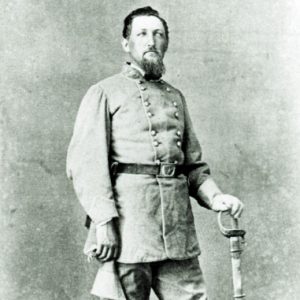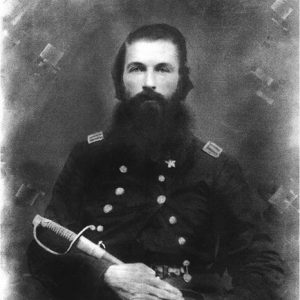calsfoundation@cals.org
Action at Mount Elba
| Location: | Cleveland County |
| Campaign: | Camden Expedition |
| Date: | March 30, 1864 |
| Principal Commanders: | Colonel Powell Clayton, Lieutenant Colonel Samuel B. Marks (US); Brigadier General Thomas Dockery (CS) |
| Forces Engaged: | Eighteenth Illinois Infantry, Twenty-eighth Wisconsin Infantry, Fifth Kansas Cavalry, First Indiana Cavalry, Seventh Missouri Cavalry (US); Crawford’s Arkansas Cavalry Brigade, elements of Poe’s and McMurtrey’s Cavalry Battalions (CS) |
| Estimated Casualties: | 4 (US); 130 (CS) |
| Result: | Union victory |
The Action at Mount Elba was fought March 30, 1864, as Confederate cavalrymen attacked Union soldiers guarding a bridge across the Saline River while other Union troops pursued a Confederate supply column at Long View (Ashley County) in an effort to disrupt Rebel operations in South Arkansas and prevent attacks on Pine Bluff (Jefferson County).
As Major General Frederick Steele led his Union army into south Arkansas from Little Rock (Pulaski County) in March 1864 on what became known as the Camden Expedition, Colonel Powell Clayton of the Fifth Kansas Cavalry prepared an expedition south from Pine Bluff to attack Confederate forces that were believed to be leaving Monticello (Drew County). The expedition—which left Pine Bluff on March 27, 1864—consisted of 237 men of the Eighteenth Illinois Infantry; 265 men of the Twenty-eighth Wisconsin Infantry under the command of Lieutenant Colonel Samuel B. Marks; and about 600 troops of the First Indiana, Fifth Kansas, and Seventh Missouri (US) cavalry regiments under the command of Lieutenant Colonel W. A. Jenkins. The Union forces had four mountain howitzers and two rifled cannon.
The combined column arrived at Mount Elba on the Saline River (near present-day Rison in Cleveland County) the afternoon of March 28, clearing away Confederate pickets and constructing a pontoon bridge across the river. (Pickets are soldiers placed in advance of larger bodies of encamped troops to watch roads and warn of approaching enemy soldiers.) The morning of March 29, Clayton left Marks at Mount Elba with all the infantry, part of the Fifth Kansas Cavalry, and three guns to protect the bridge. Clayton then advanced with the bulk of the cavalry to fight Confederate forces south of Mount Elba.
Passing through Warren (Bradley County), part of the cavalry force advanced southeast toward Long View, forty-two miles from Mount Elba. Capturing scattered Confederate troops on the road, the Union troops learned of a large supply train that had crossed the Saline River at Long View that day. The Union cavalry then charged and captured the Confederate camp. The raid on Long View resulted in the capture of about 287 men and 300 horses and mules, the burning of thirty-nine wagons and their contents, and the destruction of a bridge across the Saline. The Union troops also dumped 175 to 200 Confederate weapons into the river.
Meanwhile, Marks’s troops dug in on the north side of the Saline at Mount Elba to protect the pontoon bridge. His force consisted of the two infantry regiments, fifty-four men and two mountain howitzers of the Fifth Kansas Cavalry, and eleven men of the First Indiana Cavalry, who manned a steel rifled cannon. A scouting party set out toward Monticello the morning of March 30 and soon returned with reports that a large body of Confederate cavalry was approaching. Skirmishers of the Twenty-eighth Wisconsin Infantry held back the attacking Confederates under Brigadier General Thomas Dockery for nearly two hours as Marks prepared his defenses.
Marks placed the Eighteenth Illinois on his right, the Twenty-eighth Wisconsin and two companies of Fifth Kansas cavalrymen on the left, and the three cannon and the remaining troopers in the center. Dockery’s estimated 1,500 Confederate cavalrymen advanced through the woods toward the Union defenses, driving the Wisconsin skirmishers before them. The Confederate advance was repulsed, and Clayton and his cavalrymen charged across the pontoon bridge over the Saline River, taking over the attack and pursuing the retreating Rebels about five miles to Big Creek. The Confederate rearguard under Colonel John C. Wright had removed the planks from about 20 feet of the bridge across the creek, slowing the Union pursuit. Clayton’s troops continued to Centerville, ten to twelve miles from Mount Elba, before giving up the chase. Dockery’s forces retreated to Monticello, and Clayton’s expedition returned to Pine Bluff the next day.
What the Union gained by this action was a disruption of operations south of Pine Bluff while Steele advanced south from Little Rock. Union losses at Mount Elba consisted of two killed and two missing. Confederate casualties, besides those captured at Long View, were estimated at thirty-five killed, fifty-five wounded, and forty captured.
For additional information:
The War of the Rebellion: A Compilation of the Official Records of the Union and Confederate Armies. Series 1, Vol. 34. Washington DC: Government Printing Office, 1890–1901, p. 767–779.
Wright, John C. Memoirs of Col. John C. Wright. Pine Bluff, AR: Rare Book Publishers, 1982.
Mark K. Christ
Arkansas Historic Preservation Program







My great-great-grandfather was in this battle. He was a Confederate officer.